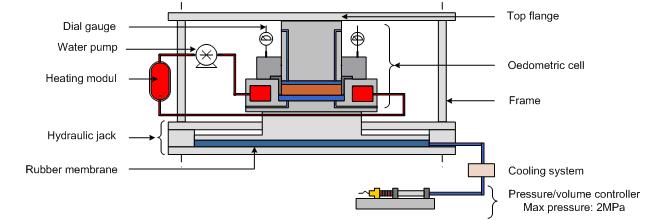THM behaviour of a soil
To investigate the effect of the temperature and the suction on the mechanical response of the clay rocks, two new devices has been developed in our lab. These apparatuses consist in oedometric cells adapted to extreme complex conditions: high pressure, temperature, and suction.

On the left, oedometric cell adapted to high pressure, temperature and suction. On the right, oedometric cell adapted to high pressure only.
Technical specifications of the oedometric cells
Main features of the apparatuses:
- Specimen dimensions: 80 mm diameter, 20 mm height
- Vertical pressure: 0 – 25 MPa
- Controlled temperature range: 20 – 90°C
- Controlled suction range (by means of vapour equilibrium technique): 4 – 400 MPa

Oedometer with vapour equilibrium technique: suction imposition system.

Oedometer with vapour equilibrium technique: vertical load and temperature application system.
Figures represent the general scheme of the THM oedometric cells. The temperature, the total vertical stress, and the relative humidity can be controlled through three independent devices. The exchanged volume of water and the vertical displacement are simultaneously measured.
The suction is controlled by means of vapour equilibrium method. A salt solution regulates the relative humidity of the atmosphere within a desiccator. A convection circuit forces this regulated atmosphere to circulate through the sample or on its boundaries. By this way, reached the equilibrium, the soil water potential is equal to the one of the vapour phase which is controlled by the atmosphere relative humidity.
The heating device consists of a ring-shaped chamber surrounding the soil sample and filled with circulating water, which is heated to the required temperature through a cryostat. In order to reduce the ambient room temperature influence, the whole oedometer is located in an insulated box.
The vertical pressure is applied by means of a hydraulic jack. The pressure in this hydraulic jack is controlled by a classical pressure/volume water controller. The ratio between the diameter of the hydraulic jack piston and the one of the sample leads to reach a high vertical pressure of 25 MPa.
Finally, the vertical displacement is measured via three dial gauges fixed on the loading piston and in contact with the base of the cell.